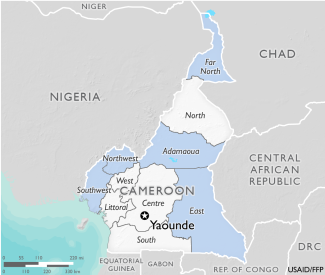April 13, 2020
Protracted crises in neighboring Nigeria and the Central African Republic (CAR), as well as civil unrest and violence in Cameroon’s Northwest and Southwest regions, are driving population displacement and exacerbating humanitarian needs in Cameroon. Overall, 3.9 million people in the country require emergency assistance to meet their basic needs, according to the UN.
Situation
- Approximately 2.6 million people in Cameroon are currently facing Crisis (Phase 3) or worse levels of acute food insecurity and are in need of food assistance—an increase of nearly 1.7 million people from the same period in 2019—according the latest Cadre Harmonisé (CH) analysis.* The increase in the reported number of acutely food insecure people is primarily due to worsening conflict in Far North, Northwest, and Southwest regions, flooding in parts of Far North in late 2019, and the expansion of the CH analysis to include all regions of Cameroon.
- Surging violence in February following Cameroon’s national elections internally displaced more than 10,000 people in Northwest and Southwest, bringing the total number of internally displaced persons (IDPs) in the two regions to approximately 679,000 as of March, according to the UN. Additionally, the UN reports that conflict in the Lake Chad Basin had internally displaced approximately 297,000 people in Cameroon and forced more than 114,000 Nigerian refugees to flee to the Far North. As of March, Cameroon also hosted nearly 294,000 refugees from CAR.
- Households in parts of Far North, Northwest, and Southwest, continue to face Crisis and Stressed (IPC 2) levels of acute food insecurity due to persistent conflict and insecurity, according to the Famine Early Warning Systems Network (FEWS NET). Resurgent organized armed group activities and localized flooding in Far North have constrained agricultural and pastoral activities. Meanwhile, insecurity in Northwest and Southwest has reduced household food stocks, prompting the lean season to start one month early in February, FEWS NET reports.
* The Integrated Food Security Phase Classification (IPC) is a standardized tool that aims to classify the severity and magnitude of food insecurity. The IPC scale, comparable across countries, ranges from Minimal (IPC 1) to Famine (IPC 5). The CH, a similar tool used only in West Africa, has a separate scale ranging from Minimal (Phase 1) to Famine (IPC 5).
Response
- USAID’s Office of Food for Peace (FFP) partners with the UN World Food Program (WFP) to provide cash-based transfers and in-kind emergency food assistance to vulnerable IDPs, host community members, and refugees residing in Adamaoua, East, and Far North. FFP also collaborates with non-governmental organizations (NGOs) to assist food-insecure people in Adamaoua and Far North through cash transfers for food and complementary activities that strengthen agricultural production and other income-generating activities.
- To assist conflict-affected populations in western Cameroon, FFP enables WFP to distribute in-kind food rations to IDPs and host community members in Northwest and Southwest. FFP also jointly supports an NGO with USAID’s Office of U.S. Foreign Disaster Assistance to provide emergency food vouchers and essential relief commodities to vulnerable people in Northwest.
Food for Peace Contributions
Total Contributions:
| U.S. Dollars | Metric Tons | |
|---|---|---|
| Fiscal Year 2020 | $18.5 million | 13,171 MT |
| Fiscal Year 2019 | $40.4 million | 31,803 MT |
| Fiscal Year 2018 | $20.4 million | 11,781 MT |
* Metric tonnage does not reflect funding for vouchers or cash transfers.
Related Resources:

